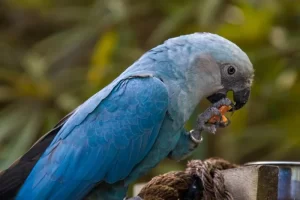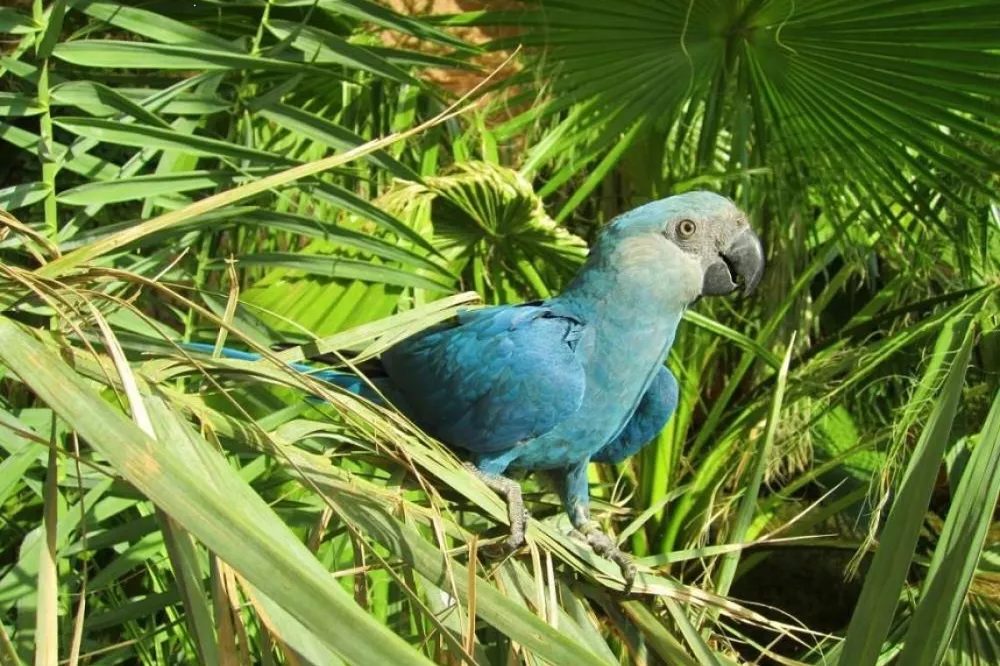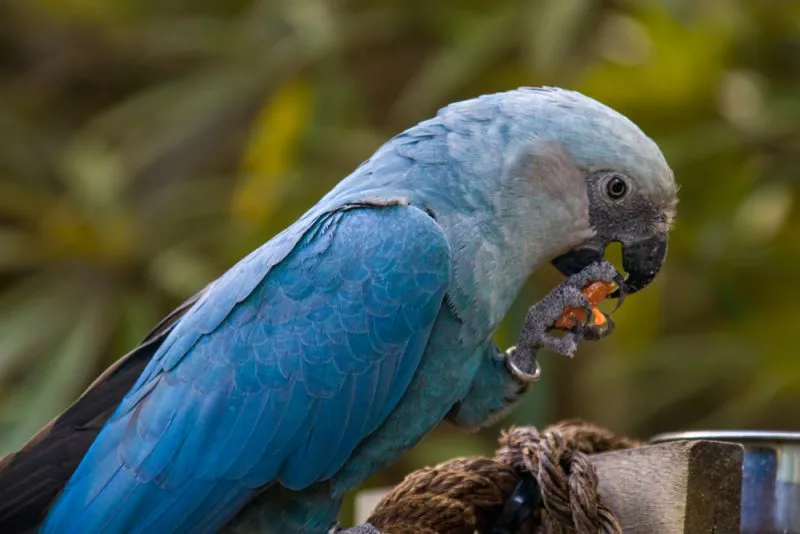
Spix’s Macaw Physical Characteristics
The Spix’s Macaw is a striking and rare bird known for its vivid coloration and distinctive features. This species, which was once thought to be extinct in the wild, is primarily recognized for its vibrant blue feathers and unique physical traits.
Size and Dimensions
Length: The Spix’s Macaw typically reaches around 55 cm (21.5 inches) in total length.
Wingspan: Its wingspan is approximately 1 meter (39 inches).
Weight: The average weight is between 300-400 grams (10.5-14 ounces).
These birds are considered medium-sized within the macaw family, which includes larger species like the Hyacinth Macaw.
Plumage and Coloration
Body Color: The most defining characteristic of the Spix’s Macaw is its blue plumage, which covers the entire body. The feathers range from light blue on the underside to a darker, rich blue on the back and wings.
Head and Face: Its face is a light bluish-gray, with a characteristic bare, white eye-ring around the eyes, giving it an almost mask-like appearance. This distinct feature is often paired with the bird’s expressive, almond-shaped dark eyes.
Beak: The beak is large, dark gray to black, and strong, characteristic of macaws, designed to crack open hard seeds and nuts.
Tail and Flight Feathers
Tail: Spix’s Macaw has a long, pointed tail that extends much longer than the body, contributing to its aerodynamic shape for strong flight.
Flight Feathers: The flight feathers are a darker shade of blue compared to the body, giving the bird a distinctive appearance when in flight.
Spix’s Macaw Habitat
Spix’s Macaw was originally found in the Brazilian state of Bahia, particularly in the region around the Rio São Francisco. Its habitat was primarily a semi-arid scrubland, known as the Caatinga biome.
Key Characteristics of the Caatinga Biome:
Climate: The Caatinga is characterized by a hot, dry climate with distinct wet and dry seasons. The dry season often sees little to no rainfall, while the wet season brings more rainfall but still remains relatively sparse.
Vegetation: The region has drought-resistant plants, such as cacti, thorny bushes, and small trees. This biome supports a unique variety of wildlife, adapted to the harsh conditions.
Spix’s Macaw Population
The Spix’s Macaw, a critically endangered species, has seen significant developments in recent years, particularly in efforts to restore its wild population. Here’s an overview of the current state of the Spix’s Macaw population:
Current Population Status
Captive Population: As of recent reports, there are approximately 360 Spix’s Macaws in captivity worldwide6. This population has grown significantly over the past decade, thanks to concerted breeding efforts.
Wild Population: The species was declared extinct in the wild in 2000, but reintroduction efforts began in 2022. The first batch of 20 birds was released into the Caatinga Forest Domain in Brazil, followed by additional releases. Currently, there are a few dozen birds living in the wild.
Spix’s Macaw Lifespan
The lifespan of the Spix’s Macaw varies depending on whether it is in the wild or in captivity.
In the wild, the lifespan is estimated to be at least 20 years, although some sources suggest it could be 20-50 years. However, due to the species’ extinction in the wild, this data is limited.
In captivity, the lifespan is generally reported to be between 20 to 40 years, with some birds living up to 34 years. The maximum documented lifespan in captivity is 34 years.
What Do Spix’s Macaws Eat?
Spix’s Macaws primarily consume a diet rich in seeds and nuts, with a focus on the native vegetation of their habitat, the Caatinga region in Brazil. Their diet includes seeds from various trees such as:
- Pinhão (Jatropha pohliana var. mollissima)
- Favela (Cnidoscolus phyllacanthus)
- Joazeiro (Ziziphus joazeiro)
- Baraúna (Schinopsis brasiliensis)
- Imburana (Commiphora leptophloeos or Bursera leptophloeos)
- Caraibeira (Tabebuia caraiba)
- Angico (Anadenanthera macrocarpa)
- Umbu (Spondias tuberosa)
- Unha-de-gato (Acacia paniculata).
In captivity, Spix’s Macaws are fed a variety of foods including seeds, fruits, nuts, and sometimes small amounts of meat, supplemented with vitamins and minerals to ensure a balanced diet.
Spix’s Macaws Photos
8 facts about the Spix’s Macaws
Here are 8 key facts about the Spix’s Macaw:
1. Scientific Classification: The Spix’s Macaw is scientifically known as Cyanopsitta spixii. It belongs to the family Psittacidae and is part of the tribe Arini in the subfamily Arinae.
2. Common Name: It is also known as the Little Blue Macaw due to its vibrant blue plumage.
3. Appearance: The bird measures about 55-56 cm (21.7-22 inches) in length, with a grey-blue head, pale blue underparts, and vivid blue upperparts. It has pale yellow eyes and a black, curved beak.
4. Habitat: Historically, Spix’s Macaws inhabited the desert woodlands of Brazil, specifically the Caatinga region.
5. Diet: In the wild, they were primarily herbivores, consuming seeds, fruits, and other plant materials. In captivity, their diet includes seeds, fruits, nuts, and supplements.
6. Behavior: These birds are monogamous, mating for life. They are diurnal, active during the day, and follow a precise daily routine.
7. Vocal Abilities: Spix’s Macaws are known for their ability to mimic human voices, which contributed to their popularity in the illegal pet trade.
8. Life Expectancy: In captivity, Spix’s Macaws can live up to 34 years.
You May Also Like
Spix’s Macaw, also known as the Little Blue Macaw or Cyanopsitta spixii, is a rare and endangered bird species native to Brazil. This beautiful parrot has captured the hearts of …
Spix’s Macaw, also known as the Little Blue Macaw, is a rare, critically endangered species of bird that is native to Brazil. These stunning birds are best known for their …
Macaws are known for their vibrant colors and playful personalities. They are one of the most popular parrot species, and their beauty and intelligence make them a favorite among pet …




 Facebook
Facebook  Instagram
Instagram  Youtube
Youtube 